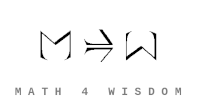- MathNotebook
- MathConcepts
- StudyMath
- Geometry
- Logic
- Bott periodicity
- CategoryTheory
- FieldWithOneElement
- MathDiscovery
- Math Connections
Epistemology
- m a t h 4 w i s d o m - g m a i l
- +370 607 27 665
- My work is in the Public Domain for all to share freely.
- 读物 书 影片 维基百科
Introduction E9F5FC
Questions FFFFC0
Software
Bott periodicity, Bott Periodicity for Octonion Maniacs
Understand the significance of the octonions.
Rotations
- Complex numbers describes rotations in two-dimensions, and quaternions can be used to describe rotations in three dimensions. Is there a connection between octonions and rotations in four dimensions?
Clifford algebras
- Relate the octonions to Clifford algebras. Compare the (associative) Clifford algebra construction with the (nonassociative) Cayley-Dickson construction. Give combinatorial interpretations of both and see how they differ.
- Is the Cayley-Dickson construction associative up to plus or minus signs (up to reflection)?
Modeling cognition
- How are the (nonassociative) octonions relate to the (associative) split-biquaternions?
- Compare the learning three-cycle (for the quaternions) and Fano's plane (eightfold way) for the octonions.
- Is there a way that the octonions get identified with the reals? The eightsome = nullsome gets understood as a onesome? And the identification of nullsome with onesome is related to the field with one element. And we are left with exceptional Lie structures.
Readings
- John Baez. The Octonions
- The Peculiar Math That Could Underlie the Laws of Nature, about Cohl Furey
- Hughes, Mia. Octonions and supergravity
- Many articles at archive.org
- Eschenburg. Geometry of Octonions Relates the representations of Clifford algebras to the normed division algebras. Identifies the octonions with the representations for {$Cl_{0,4}$}, {$Cl_{0,4}$}, {$Cl_{0,4}$}, {$Cl_{0,4}$} and identifies {$M_2(\mathbb{O})$} with the representations for {$Cl_{0,8}$}. Gives a proof of Bott periodicity in terms of symmetric spaces, symmetric subspaces, poles and centrioles.
Books
- Tevian Dray, Corinne Manogue. The Geometry of the Octonions. Lie groups, Hopf fibrations, {$E_8$} lattice.
- Conway, Smith. On Quaternions and Octonions.
- Springer, Veldkamp. Octonions, Jordan Algebras and Exceptional Groups (Springer Monographs in Mathematics.
- Dixon. Division Algebras:: Octonions Quaternions Complex Numbers and the Algebraic Design of Physics (Mathematics and Its Applications.
- Susumo Okubo. Introduction to Octonion and Other Non-Associative Algebras in Physics
 Voight. Quaternion algebras.
Voight. Quaternion algebras.
Louis Kauffman. From Hamilton's Quaternions to Graves and Cayley's Octonions Octonions take us through the Looking Glass {$L$}.
- {$LL=-I$}
- {$La=-aL$}
- {$(La)(Lb)=Lba$}
- {$(La)b=L(ba)$}
- {$a(Lb)=L(ba)$}
This yields nonassociativity (based on the "subtractiveness" of the mirror)
- {$(Lb)a=L(ab)$} but in general {$L(ab)\neq L(ba)$} because of noncommutativity {$ab\neq ba$}
The Octonions form seven copies of the quaternions, one for each copy of the circle in the Fano projective plane.
- 3 of the form {$j(Li)=Lk, (Li)(Lk)=j, (Lk)j=Li$} outer edges of triangle
- 3 of the form {$L(jL)=j, (jL)j=L,j(L)=jL$} across the center
- 1 of the form {$ij=k,jk=i,ki=j$} inner circle
- what is missing is a line relating the three corners of the triangle {$Li,Lj,Lk$}. Their product is {$L$}.
Hackett, Kauffman described the belt trick for the octonions where {$L$} plays the role of a context switch or a mirror. They imagine it as a sphere around the belt trick. You can rotate the sphere 180 degrees whereas the quaternions turn at the base.
- Proposition 3.5. (Clifford action of imaginary octonions) Consider the Clifford algebra {$Cl(Im(\mathbb{O}),−|−^2)$} on the underlying real vector space of that of the imaginary octonions regarded as an inner product space via the quadratic form given by the negative square norm. Then the operation of left multiplication on {$\mathbb{O}$} induces a representation of this Clifford algebra on {$\mathbb{R}^8\cong_\mathbb{R}\mathbb{O}$}.
- By the classification of real Clifford algebras, {$Cl_{0,7}$} has, up to isomorphism, two different irreducible modules. Their underlying vector space is {$\mathbb{R}^8\cong_\mathbb{R}\mathbb{O}$} in both cases, and so the left action of imaginary octonions we have must be one of the two. The two irreps may be distinguished by the action of the “volume element” {$\Gamma_7 Gamma_6\cdots \Gamma_1$}: On one of the two it acts as the identity, on the other as minus the identity. Hence we may check the remaining sign by acting on any one octonion, for instance on the unit {$1\in\mathbb{O}$}.
Facts about octonions
- John Baez, based on Dixon: The group of symmetries (or technically, "automorphisms") of the octonions is the exceptional group {$G_2$}, which contains {$SU(3)$}. To get {$SU(3)$}, we can take the subgroup of {$G_2$} that preserves a given unit imaginary octonion... say {$e_1$}.
Modeling with octonions
- The octonions can model the nonassociativity of perspectives.
- The Clifford algebra {$\textrm{Cl}_{0,7}$} with seven generators (squaring to {$-1$}) and {$2^7$} basis elements models the sevensome. The Clifford algebra {$\textrm{Cl}_{0,3}$}, the split-biquaternions, with three generators (squaring to {$-1$}) and {$2^3$} basis elements models the threesome. The octonions have three generators and eight basis elements.
Octonions, standard model and unification. 2023.
Notes

